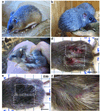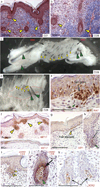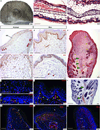Skin shedding and tissue regeneration in African spiny mice (Acomys)
- PMID: 23018966
- PMCID: PMC3480082
- DOI: 10.1038/nature11499
Skin shedding and tissue regeneration in African spiny mice (Acomys)
Abstract
Evolutionary modification has produced a spectrum of animal defence traits to escape predation, including the ability to autotomize body parts to elude capture. After autotomy, the missing part is either replaced through regeneration (for example, in urodeles, lizards, arthropods and crustaceans) or permanently lost (such as in mammals). Although most autotomy involves the loss of appendages (legs, chelipeds, antennae or tails, for example), skin autotomy can occur in certain taxa of scincid and gekkonid lizards. Here we report the first demonstration of skin autotomy in Mammalia (African spiny mice, Acomys). Mechanical testing showed a propensity for skin to tear under very low tension and the absence of a fracture plane. After skin loss, rapid wound contraction was followed by hair follicle regeneration in dorsal skin wounds. Notably, we found that regenerative capacity in Acomys was extended to ear holes, where the mice exhibited complete regeneration of hair follicles, sebaceous glands, dermis and cartilage. Salamanders capable of limb regeneration form a blastema (a mass of lineage-restricted progenitor cells) after limb loss, and our findings suggest that ear tissue regeneration in Acomys may proceed through the assembly of a similar structure. This study underscores the importance of investigating regenerative phenomena outside of conventional model organisms, and suggests that mammals may retain a higher capacity for regeneration than was previously believed. As re-emergent interest in regenerative medicine seeks to isolate molecular pathways controlling tissue regeneration in mammals, Acomys may prove useful in identifying mechanisms to promote regeneration in lieu of fibrosis and scarring.
Figures




Comment in
-
Regenerative biology: Skin, heal thyself.Nature. 2012 Sep 27;489(7417):508-10. doi: 10.1038/489508a. Nature. 2012. PMID: 23018959 No abstract available.
-
African spiny mouse: Real skin shedding meets mythology.Nature. 2012 Nov 22;491(7425):527. doi: 10.1038/491527e. Nature. 2012. PMID: 23172208 No abstract available.
-
Rapid healing and skin regeneration in the African spiny mouse.Regen Med. 2013 Jan;8(1):17-8. Regen Med. 2013. PMID: 23390632 No abstract available.
References
-
- Maginnis TL. The costs of autotomy and regeneration in animals: a review and framework for future research. Behavioral Ecology. 2006;17:857–872.
-
- Shargal E, Rath-Wolfson L, Kronfeld N, Dayan T. Ecological and histological aspects of tail loss in spiny mice (Rodentia : Muridae, Acomys) with a review of its occurrence in rodents. Journal of Zoology. 1999;249:187–193.
-
- Bauer AM, Russell AP, Shadwick RE. Mechanical-Properties and Morphological Correlates of Fragile Skin in Gekkonid Lizards. Journal of Experimental Biology. 1989;145:79–102.
-
- Kragl M, et al. Cells keep a memory of their tissue origin during axolotl limb regeneration. Nature. 2009;460:60–65. - PubMed
-
- Dubost G, Gasc JP. The process of total tail autotomy in the South-American rodent, Proechimys. Journal of Zoology (London) 1987;212:563–572.
MeSH terms
Substances
Grants and funding
LinkOut - more resources
Full Text Sources
Other Literature Sources
Research Materials

